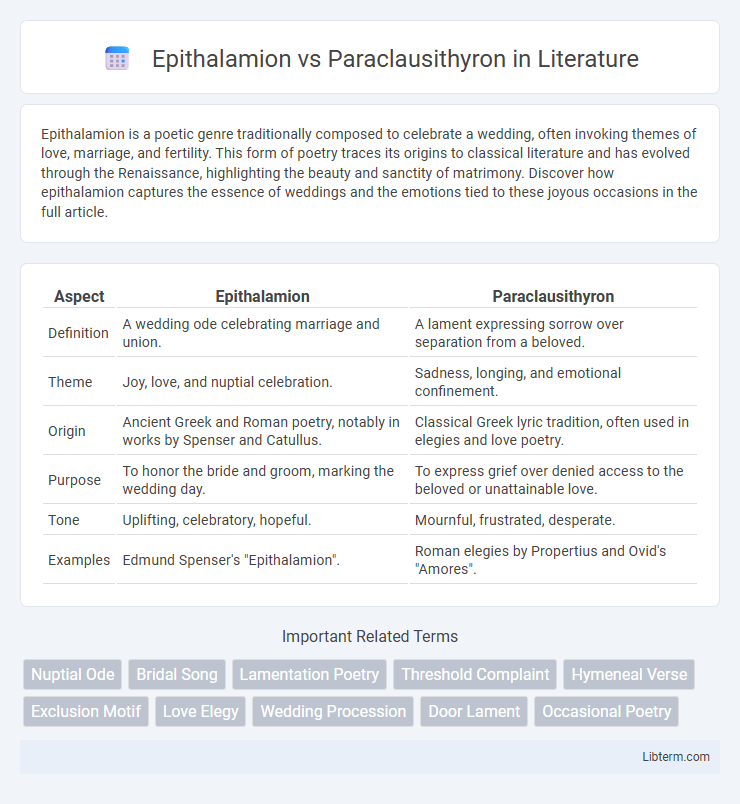Epithalamion is a poetic genre traditionally composed to celebrate a wedding, often invoking themes of love, marriage, and fertility. This form of poetry traces its origins to classical literature and has evolved through the Renaissance, highlighting the beauty and sanctity of matrimony. Discover how epithalamion captures the essence of weddings and the emotions tied to these joyous occasions in the full article.
Table of Comparison
| Aspect | Epithalamion | Paraclausithyron |
|---|---|---|
| Definition | A wedding ode celebrating marriage and union. | A lament expressing sorrow over separation from a beloved. |
| Theme | Joy, love, and nuptial celebration. | Sadness, longing, and emotional confinement. |
| Origin | Ancient Greek and Roman poetry, notably in works by Spenser and Catullus. | Classical Greek lyric tradition, often used in elegies and love poetry. |
| Purpose | To honor the bride and groom, marking the wedding day. | To express grief over denied access to the beloved or unattainable love. |
| Tone | Uplifting, celebratory, hopeful. | Mournful, frustrated, desperate. |
| Examples | Edmund Spenser's "Epithalamion". | Roman elegies by Propertius and Ovid's "Amores". |
Introduction to Epithalamion and Paraclausithyron
Epithalamion is a classical poetic form celebrating marriage, traditionally composed to honor the bride and groom on their wedding day, emphasizing themes of union, joy, and fertility. Paraclausithyron, in contrast, originates from ancient Greek or Roman love elegy, depicting a lover lamenting outside the beloved's locked door, symbolizing separation and unfulfilled desire. Both forms explore distinct aspects of love poetry, with Epithalamion focusing on matrimonial celebration and Paraclausithyron on romantic absence and yearning.
Historical Origins of Epithalamion
Epithalamion originated in ancient Greek and Roman traditions as a poetic form celebrating nuptial ceremonies, often performed outside the bride's chamber to invoke blessings for fertility and marital happiness. The genre evolved through the Renaissance, with notable contributions by poets like Edmund Spenser, who infused it with elaborate imagery and classical allusions. Unlike Paraclausithyron, which expresses the lover's lament outside a closed door, Epithalamion distinctly emphasizes joyful celebration and auspicious beginnings in matrimonial contexts.
Historical Evolution of Paraclausithyron
Paraclausithyron, a motif originating in ancient Greek and Roman poetry, evolved as a lament of a lover barred from the beloved's door, symbolizing emotional and physical separation. This literary device influenced Renaissance and Elizabethan love poetry, where it often contrasted the celebratory tone of Epithalamion, a bridal song praising nuptial union. The historical evolution of Paraclausithyron reflects shifting cultural attitudes towards love, desire, and social constraints in courtly and pastoral traditions.
Key Themes in Epithalamion Poetry
Epithalamion poetry centers on themes of marriage, love, and celebration, often depicting the joyous union of bride and groom through vivid imagery and ritualistic elements. Key motifs include the sanctity of marital vows, the intertwining of natural and spiritual realms, and the anticipation of a prosperous, harmonious life together. Contrastingly, Paraclausithyron poetry explores themes of separation, longing, and unfulfilled desire, emphasizing emotional lament rather than festive union.
Major Motifs in Paraclausithyron Poems
Paraclausithyron poems prominently feature motifs of isolation and unfulfilled desire, often portraying the poet's lament beside the locked door of a beloved, symbolizing emotional and physical barriers. Themes of longing intertwine with the harshness of rejection, emphasizing the pain of separation and the persistence of hope despite despair. These motifs contrast with the celebratory and harmonious imagery found in Epithalamion, highlighting the contrasting emotional landscapes between the two poetic forms.
Structural Differences Between the Two Forms
Epithalamion is a celebratory poem structured to honor a marriage, typically featuring a progression from invitation, praise, and blessings, culminating in joyful imagery symbolizing union and fertility. Paraclausithyron centers on the motif of a lover lamenting being shut out from their beloved, often structured around a repetitive refrain evoking longing and emotional distress, emphasizing separation and desire. The epithalamion's structure promotes a joyful resolution, while the paraclausithyron employs a cyclical format to intensify the sense of unattainable love and sorrow.
Cultural Significance and Social Function
Epithalamion, a traditional nuptial song or poem, celebrates marriage and portrays the joyful transition into wedded life, reflecting societal values of union and fertility in classical cultures. Paraclausithyron, often a lament or complaint about separation from a beloved, embodies themes of longing and emotional distress, revealing the personal and social stresses related to love and absence in ancient poetic traditions. Together, these forms illustrate contrasting emotional states within romantic relationships, serving distinct cultural functions: one honoring communal rites of passage, the other expressing individual grief and desire.
Notable Examples and Famous Poets
Epithalamion, a classical genre celebrating weddings, features notable examples by Edmund Spenser, whose "Epithalamion" remains a seminal work praising nuptial joy. Paraclausithyron, focusing on the lover's lament outside the beloved's door, is famously exemplified by Latin poet Catullus in his poignant poems expressing longing and rejection. Both genres, rooted in ancient tradition, showcase distinct emotional states through the works of renowned poets spanning from Roman to Renaissance literature.
Influence on Modern Literature
Epithalamion, a traditional wedding ode celebrating nuptial joy, and Paraclausithyron, a lament of love's separation, have profoundly shaped modern literature's exploration of romantic themes. Contemporary poets and novelists often draw on Epithalamion's motifs of celebration and union to frame narratives of love's fulfillment, while Paraclausithyron's expression of longing and emotional turmoil informs depictions of unrequited or lost love. These classical forms enrich modern literary devices by providing archetypal emotional contrasts that deepen character development and thematic complexity.
Comparative Analysis: Epithalamion vs Paraclausithyron
Epithalamion celebrates marriage and joyful union through vivid imagery and uplifting tone, while Paraclausithyron laments separation and emotional anguish using somber metaphors and melancholic mood. Both genres originate from classical Greek and Roman traditions but serve contrasting emotional purposes--Epithalamion emphasizes hope and celebration, Paraclausithyron focuses on sorrow and longing. The comparative analysis reveals that Epithalamion's structure often includes processional and communal elements, whereas Paraclausithyron employs solitary and introspective expressions of love's trials.
Epithalamion Infographic

 libterm.com
libterm.com